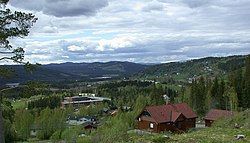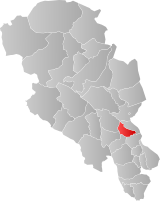Snertingdal Municipality
Snertingdal Municipality
Snertingdal herred | |
|---|---|
| Snertingdalen herred (historic name) | |
 View of the Snertingdal valley | |
 Oppland within Norway | |
 Snertingdal within Oppland | |
| Coordinates: 60°54′56″N 10°44′25″E / 60.9156°N 10.7402°E | |
| Country | Norway |
| County | Oppland |
| District | Vestoppland |
| Established | 1 Jan 1910 |
| • Preceded by | Biri Municipality |
| Disestablished | 1 Jan 1964 |
| • Succeeded by | Gjøvik Municipality |
| Administrative centre | Seegård |
| Area (upon dissolution) | |
• Total | 220 km2 (80 sq mi) |
| Population (1964) | |
• Total | 2,471 |
| • Density | 11/km2 (29/sq mi) |
| Demonym | Snertingdøl[1] |
| Official language | |
| • Norwegian form | Bokmål[2] |
| Time zone | UTC+01:00 (CET) |
| • Summer (DST) | UTC+02:00 (CEST) |
| ISO 3166 code | NO-0526[4] |
Snertingdal is a former municipality in the old Oppland county, Norway. The 220-square-kilometre (85 sq mi) municipality existed from 1910 until its dissolution in 1964. The area is now part of Gjøvik Municipality in the traditional district of Vestoppland. The administrative centre was the village of Seegård.[5]
History
[edit]

The municipality of Snertingdal was established on 1 January 1910 when the municipality of Biri was divided in half. The western part (population: 2,028) became Snertingdal Municipality and the eastern part (population: 2,815) continued as Biri Municipality.[6]
During the 1960s, there were many municipal mergers across Norway due to the work of the Schei Committee. On 1 January 1964, the municipality of Snertingdal (population: 2,471) was merged with the town of Gjøvik (population: 8,251), the municipality of Biri (population: 3,274), and most of the municipality of Vardal (population: (9,612) to create a new Gjøvik Municipality with 23,608 residents.[6]
Name
[edit]The municipality is named after the Snertingdalen valley (Old Norse: Snartheimsdalr) which runs through the municipality. The first element of the valley name is Snartheimr which comes from the old "Snartum" farm and church site in the valley. The farm name is likely derived from an old river name with the suffix heimr which means "home". The last element of the valley name is dalr which means "valley" or "dale".[7][5]
Historically, the name of the municipality was spelled Snertingdalen. On 3 November 1917, a royal resolution changed the spelling of the name of the municipality to Snertingdal, removing the definite form ending -en.[8]
Government
[edit]While it existed, this municipality was responsible for primary education (through 10th grade), outpatient health services, senior citizen services, unemployment, social services, zoning, economic development, and municipal roads. During its existence, this municipality was governed by a municipal council of directly elected representatives. The mayor was indirectly elected by a vote of the municipal council.[9]
Mayors
[edit]The mayors of Snertingdal:[10]
Municipal council
[edit]The municipal council (Herredsstyre) of Snertingdal was made up of 17 representatives that were elected to four year terms. The party breakdown of the final municipal council was as follows:
| Party name (in Norwegian) | Number of representatives | |
|---|---|---|
| Labour Party (Arbeiderpartiet) | 10 | |
| Centre Party (Senterpartiet) | 5 | |
| Liberal Party (Venstre) | 2 | |
| Total number of members: | 17 | |
| Party name (in Norwegian) | Number of representatives | |
|---|---|---|
| Labour Party (Arbeiderpartiet) | 9 | |
| Farmers' Party (Bondepartiet) | 5 | |
| Liberal Party (Venstre) | 3 | |
| Total number of members: | 17 | |
| Party name (in Norwegian) | Number of representatives | |
|---|---|---|
| Labour Party (Arbeiderpartiet) | 9 | |
| Farmers' Party (Bondepartiet) | 4 | |
| Liberal Party (Venstre) | 3 | |
| Total number of members: | 16 | |
| Party name (in Norwegian) | Number of representatives | |
|---|---|---|
| Labour Party (Arbeiderpartiet) | 8 | |
| Farmers' Party (Bondepartiet) | 4 | |
| Joint list of the Liberal Party (Venstre) and the Radical People's Party (Radikale Folkepartiet) | 4 | |
| Total number of members: | 16 | |
| Party name (in Norwegian) | Number of representatives | |
|---|---|---|
| Labour Party (Arbeiderpartiet) | 8 | |
| Farmers' Party (Bondepartiet) | 3 | |
| Joint list of the Liberal Party (Venstre) and the Radical People's Party (Radikale Folkepartiet) | 5 | |
| Total number of members: | 16 | |
| Party name (in Norwegian) | Number of representatives | |
|---|---|---|
| Labour Party (Arbeiderpartiet) | 8 | |
| Farmers' Party (Bondepartiet) | 5 | |
| Joint list of the Liberal Party (Venstre) and the Radical People's Party (Radikale Folkepartiet) | 3 | |
| Total number of members: | 16 | |
| Note: Due to the German occupation of Norway during World War II, no elections were held for new municipal councils until after the war ended in 1945. | ||
See also
[edit]References
[edit]- ^ "Navn på steder og personer: Innbyggjarnamn" (in Norwegian). Språkrådet.
- ^ "Norsk Lovtidende. 2den Afdeling. 1932. Samling af Love, Resolutioner m.m". Norsk Lovtidend (in Norwegian). Oslo, Norway: Grøndahl og Søns Boktrykkeri: 453–471. 1932.
- ^ "Forskrift om målvedtak i kommunar og fylkeskommunar" (in Norwegian). Lovdata.no.
- ^ Bolstad, Erik; Thorsnæs, Geir, eds. (26 January 2023). "Kommunenummer". Store norske leksikon (in Norwegian). Kunnskapsforlaget.
- ^ a b Thorsnæs, Geir, ed. (28 January 2020). "Snertingdalen". Store norske leksikon (in Norwegian). Kunnskapsforlaget. Retrieved 14 October 2022.
- ^ a b Jukvam, Dag (1999). Historisk oversikt over endringer i kommune- og fylkesinndelingen (PDF) (in Norwegian). Statistisk sentralbyrå. ISBN 9788253746845.
- ^ Rygh, Oluf (1900). Norske gaardnavne: Kristians amt (in Norwegian) (4 ed.). Kristiania, Norge: W. C. Fabritius & sønners bogtrikkeri. pp. 16 and 19.
- ^ "Norsk Lovtidende. 2den Afdeling. 1917. Samling af Love, Resolutioner m.m". Norsk Lovtidend (in Norwegian). Kristiania, Norge: Grøndahl og Søns Boktrykkeri: 1057–1065. 1917.
- ^ Hansen, Tore; Vabo, Signy Irene, eds. (20 September 2022). "kommunestyre". Store norske leksikon (in Norwegian). Kunnskapsforlaget. Retrieved 1 January 2023.
- ^ Lauvdal, Torgeir (1930). Vardal bygdebok (in Norwegian). Vol. 3. Gjøvik, Norge.
{{cite book}}: CS1 maint: location missing publisher (link) - ^ "Kommunevalgene og Ordførervalgene 1959" (PDF) (in Norwegian). Oslo, Norge: Statistisk sentralbyrå. 1960.
- ^ "Kommunevalgene og Ordførervalgene 1955" (PDF) (in Norwegian). Oslo, Norge: Statistisk sentralbyrå. 1957.
- ^ "Kommunevalgene og Ordførervalgene 1951" (PDF) (in Norwegian). Oslo: Statistisk sentralbyrå. 1952.
- ^ "Kommunevalgene og Ordførervalgene 1947" (PDF) (in Norwegian). Oslo: Statistisk sentralbyrå. 1948.
- ^ "Kommunevalgene og Ordførervalgene 1945" (PDF) (in Norwegian). Oslo: Statistisk sentralbyrå. 1947.
- ^ "Kommunevalgene og Ordførervalgene 1937" (PDF) (in Norwegian). Oslo: Statistisk sentralbyrå. 1938.

